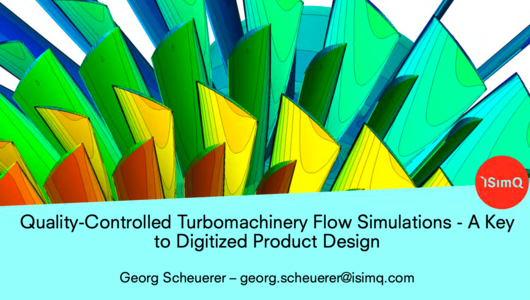
Georg Scheuerer from ISIMQ presented on "Quality-Controlled Turbomachinery Flow Simulations - A Key to Digitized Product Design," focusing on the role of simulation in the design of various turbomachines like gas, steam, wind, and water turbines, as well as pumps, fans, compressors, and propellers. The industry trend emphasizes the shift from 'Product before simulation' to 'Simulation before product', reflecting the increased digitization in both OEMs and SMEs. The presentation outlines a comprehensive CFD simulation workflow for turbomachinery, which includes problem analysis, requirements documentation, target quantities, resource allocation, and model selection (considering aspects like turbulence, heat transfer, rotor-stator interaction, and multi-phase flows). The workflow also entails detailed geometry modeling, mesh generation (considering size and quality), setting initial and boundary conditions with associated uncertainties, solver selection, hardware choices, and both qualitative and quantitative analysis. Quality control measures are embedded throughout the process, with focus on iteration, discretisation, model uncertainties, and thorough documentation. A specific test case of a 1.5-stage high-pressure turbine is presented, involving stator-rotor-stator interactions, tip clearance flows, and main flow-cavity interaction, with data sets from ETH Zürich. The presentation discusses the mathematical models used for simulating turbomachines, covering basic conservation equations, turbulence, heat transfer, rotor-stator interaction, and multi-phase flows. The study particularly focuses on rotor-stator interaction using steady mixing plane and unsteady sliding mesh approaches and ensemble-averaged mass, momentum, and enthalpy equations (URANS). Boundary conditions and meshing considerations are elaborated, highlighting the importance of numerical accuracy, mesh type and quality, shear layer resolution, and near-wall mesh sizing for high accuracy. The presentation also covers quality assurance through error hierarchy, including iteration error, discretisation error, model and systematic error, and details the discretisation error estimation process. Results from steady-state and unsteady-state baseline cases are presented, including comparisons with available data. In conclusion, the presentation emphasizes the significance of high-quality simulations in turbomachinery design, underscoring the necessity of quality control and accuracy quantification for making informed design decisions. This approach is deemed essential for achieving optimized designs and maintaining a competitive edge in the field of aerodynamics and hydraulics.



